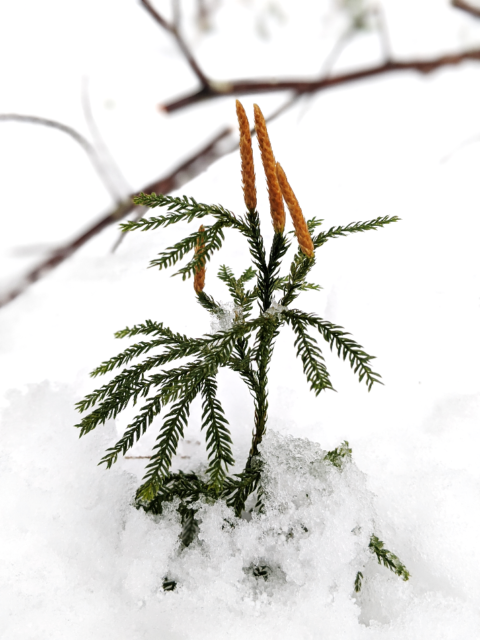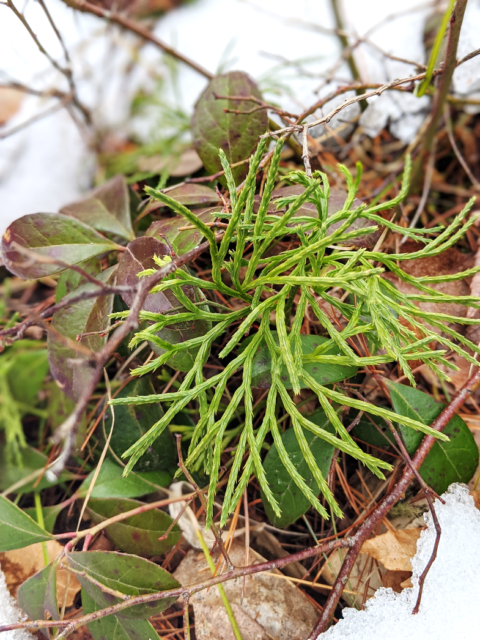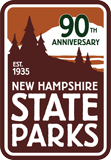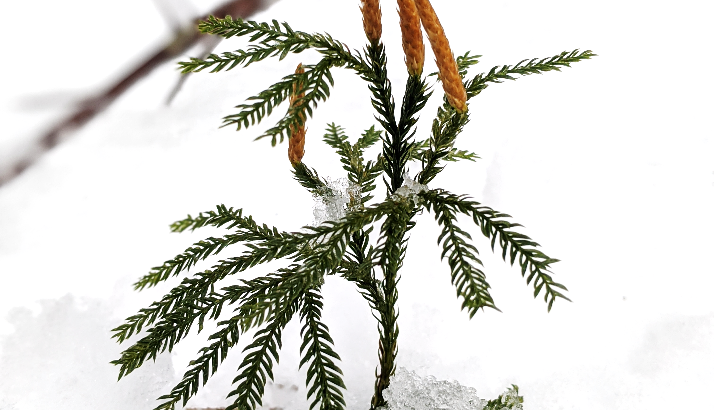By: Katherine Kelly
As you are taking a winter stroll in Bear Brook State Park, you may come across a Princess Pine peeking through the snow. At first glance this plant looks like a small evergreen sapling: green, needle-like leaves and a pine tree silhouette. Look closer and you may see that the stem is not woody, but covered in the same green pointed leaves. A tiny golden cone structure might be perched near the top of the plant.
When I first saw this plant—or rather, a picture of this plant—I rashly thought, “that’s a Hemlock sapling!” However, I had not looked closely enough at the size of the plant, or the leaves. The plant was only a few inches tall and the leaves were not needles.

Photo credit: K. Kelly
You may have guessed by now this plant is not a pine or any coniferous tree. The Princess Pine is actually a clubmoss. Do not be fooled by this name either: clubmosses are not true mosses, a more ancient relative of all plants. The clubmosses are more closely related to the ferns and the horsetails. The cone-shaped flower of the Princess Pine is a strobilus (plural: strobili), a spore-bearing reproductive structure comparable to the spore-bearing sori of ferns.
Although these plants generally colonize the understory today, massive forests of tree-sized clubmosses, ferns, and horsetails used to dominate the landscape 400 million years ago. Over time, these forests were buried and compacted into what we know today as coal.
The Ground Cedar is another clubmoss you may come across in Bear Brook State Park. As the name suggests, the Ground Cedar looks like a cedar—an evergreen with flattened, scale-like leaves. Like the Princess Pine, the Ground Cedar might have a strobilus, providing a key clue that this plant is a clubmoss.

Photo credit: K. Kelly
Although the clubmosses no longer grow to towering heights, they are still an ancient marvel of the plant world. What I thought would be a simple plant identification turned into a mystery of misnomers: a “pine” that was not a pine; a “moss” that was not a moss. Next time I see something green peeking out of the snow, I will withhold assumptions and instead take a closer look.
For further reading, check out The Book of Forest and Thicket: Trees, Shrubs, and Wildflowers of Eastern North America by John Eastman and The Shrub Identification Book by George W.D. Symonds.


I saw these the other day while walking in the woods with my husband. I thought they were saplings. Thank you for the clarification. I enjoyed your article.
Both grows in undisturbed oak, pine and beech forest. Another example is bear grass. Does not fit the name but would it fit this category?
As a child in Rhode Island at Christmas time we would gather it to make wreaths every year. Now walking in the woods I never see it. So sad
Kathleen,
the Facebook group, Native Plants of the Northeast had quite a lively discussion on Princess Pine a couple of days ago.
I sent the group this article.
I have been picking princess pine to make Christmas wreaths since I was a kid in the 1960s. We would ride horses into the forest and pick bags full at a time.. I have been told over the years that picking princess pine is not allowed. Is this protected in anyway?
Thank you.
Great article – as for the Latin – well – as a plant person all my life who has worked in too many greenhouses I find that common names help us to identify a plant just as well thanks to the internet!